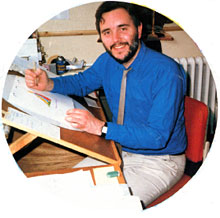David Jefferson went along to the Animus animation studio in London to meet Tony White, author of a new book on animation techniques called The Animator’s Workbook.
David Jefferson: What prompted you to write The Animator’s Workbook?

Tony White: When we were making Cathedral, a year-and-a-half ago, we had a full time staff of forty working on it for eight months. We have a small regular staff so the rest were freelancers. Many were not trained animators and they kept asking how things were done, so I thought that the logical way of showing them would be to have a series of lectures. We closed the studio down every Friday morning for ten weeks and I gave a lecture. Each week I would set an assignment and they would bring it along the following week, we would shoot it on the video camera and show the tests at the beginning of the next week. I prepared each lecture with typed notes and did little thumb-nail sketches. I would give the lecture and then present everyone with a copy of the notes. I ended up with ten weeks of lecture notes.
Students often ask us where they can get a good book on animation. There isn’t a definitive book on the type of animation we do, the Disney style. The Frank Thomas & Ollie Johnston book Disney Animation: The Illusion of Life is a marvellous biography of the studio but there is not much in there for the beginner.
D. J.: I found that it made me feel like giving up, they set such a high target.

T.W.: That’s what I mean. Frank Thomas is my idol, he is a wonderful man. That is a book for people who have a lot of experience under their belt, they can pick the bones from it. The Preston Blair book Animation only goes so far and none of the other books cover animation to the degree that we are working with as professionals. I had all these notes and people who had been on the course were very complimentary, they all said that they got something out of it, so I thought, why not try to get a book published? Eventually I found a publisher who was interested. It is being published in the United States by Watson-Guptill and in Britain by Phaidon Press.
The Animator’s Workbook covers every aspect from dope sheets to bar sheets, soundtracks, equipment and how the film is made. Then there is what I call the animator’s toolkit
which gives all the equipment from the very refined to the very basic. Then there is a step-by-step guide beginning with inbetweens.

There is a strong influence from my own training with Richard Williams, with Art Babbitt, Ken Harris and Frank Thomas. I don’t claim everything to be my invention, it is more a rechannelling of my experiences.
D. J.: Richard Williams ran a series of lectures with Art Babbitt.
T. W.: A lot of people at Animus are ex-Richard Williams people. I attended both the original Art Babbitt lectures and so did Richard Burdett who is the other principal director/animator here. We felt that the first one was the best, it was tremendous, he was really bright and alert and keen. Each one of us leapt several grades as animators.
I was particularly fortunate because Dick used to bring Ken Harris over from America for the summer and I was assigned as his assistant to do his inbetweens. My brief was to pick his brains for information on his technique and note it down for the benefit of the studio.
D. J.: When you gave your lectures I presume you gave people advice based on the assignments you had set.
T. W.: I gave basic instructions on all aspects of animation; walks, inbetweening, arcs, overlapping actions and then at the end of that session set an assignment on what we had been talking about. It would all be in matchstick men, there would be no demanding design work. Basically I was teaching movement, design and form did not matter all that much except in actual structure, for example, an arm suddenly getting shorter is wrong. All the joints and the length of the limbs had to be right but the design was with matchstick men and the book is very similar. The book is profusely illustrated with very simple characters. Other parts of the book are illustrated with full colour pictures from our advertising work and Cathedral.
